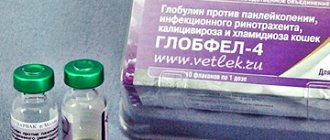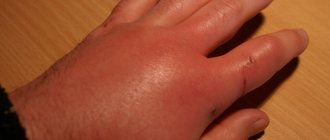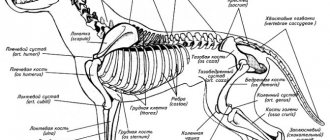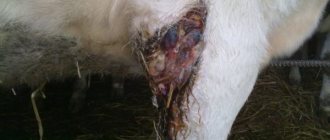What should a dog's paws look like?
Let’s note right away that if a dog always has cold paw pads from puppyhood, most likely there is no reason for concern, or you already know about them, just don’t associate them. The structure of the skin on the paws is the same for all canines, but depending on the size and load, it differs in roughness. Large four-legged animals have tenacious, rough, embossed pads, while decorative dogs have very delicate heels even in adulthood.
Normally, the paw temperature is lower than the body, but higher than the environment . Provided that the dog is at rest, the temperature of the limbs is stable. You need to understand that sleep is a state of deep rest, in which the immune system and metabolic processes are very active, which can increase the base body temperature.
Important! If you suspect that your dog's feet are too cold, measure his base body temperature. Fine? If the answer is yes, there is no need to worry too much.
What to do if your dog is lethargic
Lethargy in a dog - possible causes and actions of the owner
The treatment regimen for lethargy in a dog is developed individually, depending on the factor that provoked such a symptom. Treatment, as a rule, is complex, including conservative methods and sometimes surgical intervention. If it is not possible to eliminate the main factor, symptomatic palliative treatment is prescribed, aimed at maintaining the body’s strength and improving the pet’s quality of life.
If your dog has lost his appetite and is weak, the cause may be intoxication of the body with chemicals, medications, or poor-quality food. In case of poisoning, it is necessary to determine the underlying cause. After diagnosis, the doctor, based on research, prescribes painkillers, antispasmodics, and enterosorbents.
It is also necessary to administer hepatoprotectors to maintain liver strength, and decongestants to prevent problems with the heart and brain. If vomiting is present, antiemetic drugs are prescribed. Poisoning with chemicals requires the administration of a specific antidote.
Non-hazardous reasons
The body adapts to the external environment through thermoregulation. When the body needs to increase its temperature, it speeds up its metabolism and vice versa. That is, we can say that the temperature of the body and limbs depends on the conditions in which the animal is at a given moment in time.
At low air temperatures and at rest, the dog's paws may seem a little cool - this is normal. The body does not spend energy, metabolism slows down. This phenomenon is due to the instinct of survival, because wild dogs do not always manage to eat on time and to their full, so all the body’s reserves count.
This is interesting! The ability to control their metabolism is most clearly expressed in sled dogs. The four-legged animals run through the snow for 10–18 hours straight, manage to rest a little while moving, and at the same time breathe with their mouths open (that is, they are hot).
Too high an air temperature and a state of activity also leads to cooling of the paws, but the reason is different. Dogs cool themselves by breathing with their mouths open and secreting secretions from glands between their toes. In hot weather, the dog should have a contrastingly cold nose, and in intense heat, paw pads too. In addition, the animal will strive to lie down in a cool place; while outside, the dog will find soft soil, dig it up and lie down in a hole. By cooling the paw pads, the dog lowers its base body temperature.
Important! When sleeping, the dog's paws should be warm or even hot, especially if the air temperature in the home is high. However, there must be moderation in everything; too warm and dry air harms not only dogs, but also people.
Why does a dog have cold paws?
Some breeds have normally cold pads. In addition, the temperature in the limbs is always lower than in the entire body of the animal.
In dogs, and in other warm-blooded animals, adaptation to the environment occurs through thermoregulation. If necessary, metabolic processes in the body slow down and the temperature of the body and extremities, among other things, decreases. If the dog does not expend energy or is hot, then its paws become cold.
During extreme heat, the pads should be cold. And when the animal sleeps - hot.
If cold paws are not a typical sign for your pet, you should urgently consult a specialist. In some cases, frozen extremities are an indicator of the presence of a disease, even if there are no symptoms yet.
- vegetative-vascular dystonia and heart disease – the body is not supplied with blood in full due to a decrease in the performance of the heart. This leads to oxygen starvation and low temperature;
- vascular atherosclerosis – blood flow is impaired due to decreased elasticity of blood vessels;
- venous thrombosis – a blood clot stops blood flow;
- complete or partial paralysis – occurs as a result of injury, pinched nerve;
When injured, the temperature in the hind limbs is lower than in the front limbs.
- anemia - due to a decrease in volume, the blood in the body flows to the periphery of the body in very small quantities. It primarily supplies important organs;
- poisoning - low temperature accompanied by vomiting.
The final cause of this dog’s condition will be determined at a veterinary clinic.
How to warm a dog's paws
Perhaps you have noticed deviations from the norm and it worries you. Nothing bad will happen if you intervene and try to support the strength of your pet’s body.
If after winter walks your dog’s paws seem very cold, you need to purchase:
- Shoes with comfortable soles will protect not only from the cold, but also from the salt that is sprinkled on hiking trails and roadways.
- Socks with non-slip soles will help if you have heating problems in your home.
Note! The smaller the dog, the more important the role of shoes and clothing in keeping its body warm.
Is the floor in your house cold? Are you comfortable walking without shoes or socks? If not, insulate the person’s sleeping area. You don’t need any special tricks, just lay cardboard, polystyrene foam or thermal insulating fabric under the bed. As an experiment, your pet can be covered while sleeping.
Note! During sleep, the dog actively gives off heat and if it is cold around, then a decrease in body temperature is likely.
How to warm your pet's paws
In any case, it's worth trying to warm your paws. How to do this depends on the reason.
If you have cold paws during or after walks, you should buy dog shoes. It will protect not only from the cold, but also from reagents or salt that are sprinkled on sidewalks.
Is it because the floor is cold? Socks with anti-slip soles will help.
If the problem is the floor, then it is necessary to insulate the place where the pet sleeps. You can put cardboard or foam under the bed.
It is recommended that small dogs be covered when sleeping, as they freeze faster than larger breeds.
Possible ailments
There are many beautiful beliefs that people with cold hands have a warm heart or are in love, but as doctors say, they have vegetative-vascular dystonia... and this is in most cases true. Cold paws in four-legged animals can also indicate a number of problems that are not visible at first glance.
Immediately after a walk, the paw pads may be cold due to hypothermia. The phenomenon is temporary and usually goes away without intervention as soon as the paws warm up and the blood vessels return to their normal state. By the way, after walking in the snow, the dog’s paws should be washed with cool water, since sudden immersion in heat leads to vascular injuries.
Note! After walking in snowy weather, the dog's paw pads become hot.
- Intoxication (poisoning) - the first symptoms are vomiting and a drop in body temperature.
- Anemia - a low level of red blood cells in the blood leads to oxygen starvation of the cells. As anemia progresses, the volume of blood decreases and the body supplies it only to vital organs, that is, the paws from the pads and above become very cold.
- Partial or complete paralysis – leads to loss of sensation in the limbs. The problem may be neurological in nature (pinched nerves) or appear after an injury. Typically, with spinal injuries (involving damage to the nerves or spinal canal), it is found that the hind paws are much colder than the front paws.
- Vascular atherosclerosis is a common disease of older people and also occurs in animals. The disease is caused by changes in the walls of blood vessels; they become less elastic, which impairs blood flow in the extremities.
- Heart problems and vegetative-vascular dystonia , like any ailment of the cardiovascular system, leads to deterioration of blood flow. Survival mechanisms can work to the limit, but a diseased heart is physically unable to provide blood to the entire body, which leads to oxygen starvation of cells and a decrease in temperature.
Note! Venous blood clots can also cause low extremity temperature. Blood clots physically block blood vessels and veins, which partially or completely stops blood flow.
The dog's paws are normal
It is worth noting that some representatives of the canine world have paw pads that constantly remain cold, even from puppyhood. Often this feature is not outside the norm and is not a cause for concern.
The structure of the skin on the paws of all dogs is the same, but depending on the size and load, it varies in roughness. For example, dogs of large or giant breeds have tenacious pads covered with rough, textured skin, and miniature decorative dogs have soft, delicate, sensitive heels.
Normally, dogs' paws have a lower temperature than the rest of the body, but it should exceed the ambient temperature. If the dog is at rest, the temperature of the limbs remains stable. It is important to consider that sleep is a state of deep rest, in which the functioning of the immune system and the intensity of metabolic processes increase, which can lead to an increase in base body temperature.
Experts recommend that owners who are worried about their pet's paws being too cold measure the animal's base temperature. If the indicator is within the normal range, then there is no need to worry.
Take your dog to the vet if you notice these 12 symptoms
A responsible owner does not forget to care for his dog, gives vaccinations, carries out hygiene procedures and monitors the regime. But how can you notice in time that something is wrong with your pet and not miss the onset of a serious illness? Veterinarians say that not only dangerous syndromes, such as vomiting, bleeding or lameness, should alert the owner, but also changes in the dog’s behavior and reactions, and its character.
We at Bright Side drew attention to non-obvious signs that require taking your dog to a specialist. Some diseases in dogs, especially purebred ones, develop rapidly, and it is better to make a mistake in suspicion than to lose sight of something important. Particular vigilance must be exercised when the animal’s immunity may be weakened: during teeth changes, during periods of cold, extreme heat, and tick activity.
The dog's tail is hanging
If you notice that the dog has stopped moving its tail and it remains motionless in any condition, then most likely it may be “cold tail syndrome”. The causes of this condition are minor injuries and hypothermia of the dog, especially if the tail gets wet.
Acute inflammatory disease of the tail muscles affects mostly young large dogs, whose tail hangs like a whip either immediately from the root, or “breaks” at a distance of about 10 cm from the root. The most painful muscles may be closest to the caudal vertebrae. Dogs react poorly to the feeling of the tail, and their general health may also deteriorate, especially in the initial stage of the disease. Treatment is rest and procedures prescribed by the veterinarian. Prevention of the syndrome in winter is active walks and thorough drying of the tail after getting wet.
When cold paws are a sign of ill health
If in humans cold extremities are often a sign of various diseases - vegetative-vascular dystonia, pathologies of the thyroid gland, anemia, then in dogs this condition can signal the presence of some kind of illness. Often, cold paws indicate pathology before more obvious symptoms occur:
- Intoxication – among the first manifestations of poisoning are vomiting and a sharp drop in body temperature.
- Anemia – a decrease in the level of red blood cells in the blood provokes oxygen starvation of cells. As the disease progresses, blood volume decreases and the body diverts it to supply vital organs. The limbs are not included in this category, so the paws quickly become cold.
- Paralysis is a pathology that can be either complete or partial; it leads to loss of sensation in the limbs. Paralysis occurs against the background of neurological disorders - pinched nerve endings, or is a consequence of injury. When the spine is injured, when the nerves or spinal canal are damaged, it is often observed that the hind limbs feel colder to the touch than the front limbs.
- Vascular atherosclerosis , a similar disease that affects many older people, is often diagnosed in our little brothers. The disease develops due to changes in the vascular walls; they lose their elasticity, which significantly impairs blood flow in the extremities.
- Heart disease and vegetative-vascular dystonia are a disease in which blood flow is also impaired. Usually, the body of a sick animal begins to function intensively, but the heart cannot cope with the load; it is not able to fully provide for all organs and systems. This leads to hypoxia and a decrease in temperature.
- Venous thrombosis - blockage of veins and blood vessels also stops blood flow, and the dog’s limbs begin to get cold.
Such diseases can be very dangerous and require consultation with an experienced veterinarian and long-term treatment.
Cold paws on a dog do not always indicate the presence of a disease, but this possibility cannot be excluded. The owner should monitor the pet more closely and, if there are alarming signs, seek help from a professional.
The dog is lethargic. Dangerous and non-dangerous signs.
Dangerous and not so symptoms of apathy in a dog. The first signs of how to treat and prevent apathy.
It is common for a person to wake up sleep deprived after a hard day at work or a night at the club. This condition is rare for animals. They don't get up with a broken head. If a usually active and cheerful dog does not get up all day and does not want to go outside for a walk, then you should worry about its health.
Apathy is a state when a dog does not want to play, eat, or walk. She wants to be left alone. This condition can be caused by various reasons. Many are not dangerous to health, but there are exceptions.
Dangerous signs of lethargy in a dog
Sunstroke is a common cause of ill health in dogs. In hot weather, make sure that dogs do not stay in the sun for long periods of time. Wet your dog's fur with water. If the dog has lost consciousness, try to reduce its body temperature by taking it to the shade and moistening its nose, paw pads, belly and ears with water. Then take her to the vet immediately.
Severe moisture loss
If you are going for a walk in hot weather, be sure to bring water for your dog. Dehydration of the body is very dangerous, it leads to a decrease in heart rate, saliva in this state becomes sticky and thick.
Hypothermia
Many dogs, especially short-haired ones, do not tolerate low temperatures well. You shouldn't go for a walk when it's freezing outside. If your dog is severely hypothermic, he may experience convulsions. Forget about your pet, buy him warm overalls and boots.
Particularly dangerous cases (do not delay a trip to the veterinarian)
Poisoning
Food or chemical poisoning is very dangerous. Severe poisoning leads to dehydration. In case of poisoning, you should immediately go to a veterinary clinic. The doctor will perform a gastric lavage and give special medications.
Gastrointestinal problems
All kinds of gastrointestinal diseases from gastritis to intestinal obstruction can lead to lethargy in a dog. Also, in this condition, the dog may experience diarrhea and vomiting. Usually animals refuse to eat or drink.
If left untreated, worms can have a serious effect on your dog's body. The first symptoms are itching in the anus, disturbances in the gastrointestinal tract, blood in the stool, and gases.
Viral infections are quite diverse. Without taking tests, it is very difficult to determine the origin of the virus. It could be canine flu or rabies.
Sudden weight loss, decreased activity, refusal to eat, frequent mood changes are the first symptoms of oncology. At the beginning, the disease is very difficult to identify. Usually the diagnosis is made when the disease is in its final stages. Depending on the form, there are several treatment methods that the veterinarian will select.
Tick bite
During the summer, it is necessary to protect the dog from parasites. Buy drops or a collar specifically designed for flea and tick protection. After a walk in the park, try to examine your pet's body for a parasite bite. Typically the skin at the site of the bite is red and swollen. If you find a tick, do not try to remove it yourself; it is better to take your dog to the veterinarian.
Joint pain
Joint problems can occur not only in older dogs, but also in young ones. While walking, your dog may injure its paw. Try to pay attention to changes in the animal's gait.
At your veterinarian's appointment, explain your dog's behavior in great detail. This will help the doctor make a diagnosis and prescribe the correct treatment.
Warming your pet's paws
An attentive owner will definitely notice the changes, especially if we are talking about tiny, miniature dogs. And with proper actions, he may well correct the situation, keeping his four-legged friend’s body normal.
Usually, representatives of pocket breeds have very cold paws in winter and wet weather. In this case, the owner should take care of the following:
- purchase insulated boots for your dog - comfortable to put on and wear, with light, non-slip soles. Shoes are protection not only from the cold, but also from the reagents that are sprinkled on the road and paving slabs;
- Socks with “brakes” are suitable for the home - they help out in the off-season and if the house has heating problems;
- It is advisable to insulate your pet’s bed - this can be done using cardboard, foam plastic or thermal insulating material, which just need to be placed under the pet’s mattress or bed;
- some small dogs get cold while sleeping - if the dog belongs to the “freezing” category, then you can try covering it with a blanket. The dog is not indignant and does not try to get out, which means this is what is needed.
It is worth noting that during sleep the animal intensively gives off heat, and if it is in the cold, a natural decrease in body temperature is possible.
Possible physiological causes
Changes in a pet's well-being and behavior sometimes occur for physiological reasons. External factors can also have a negative impact on the animal.
Overwork
If your walk with your dog was long and active, he might just get tired.
Not all breeds have high endurance. Animals get overtired too, just like people. The dog may lie for some time and not react to others. Let him rest. If, after several hours of lethargy, his usual cheerfulness returns, it means that everything is in order and there is no need to sound the alarm.
Dehydration
Lack of fluid causes electrolyte deficiency. Due to dehydration, blood thickens, increasing the risk of thrombosis and kidney failure. The dog urgently needs to be given water and allowed to rest. In severe cases, a drip is required.
Heatstroke or sunstroke
Dogs do not have sweat glands. Thermoregulation is achieved by breathing through an open mouth. In very stuffy conditions, in the sun, or in the heat, the animal may well become overheated. Symptoms of sun/heatstroke include lethargy, refusal to eat, vomiting, and extreme thirst. Provide your pet with coolness and peace. It is recommended to pour cool water over the dog.
Insect bite
In the grass, in nature, the dog runs the risk of picking up harmful insects. It can be stung by a wasp or a bee, as well as a tick and any other dangerous pest.
If the dog becomes lethargic after a tick bite, there is a possibility of infection. Ticks can carry infections such as ehrlichiosis, bartonellosis, borreliosis, etc. A wasp or bee sting causes an allergic reaction. Bedbugs cause severe itching, swelling and intoxication. In such cases, self-medication is unacceptable. An urgent visit to the veterinarian is required.
Poisoning and overeating
Not all animals can control their appetite. Young puppies are often susceptible to overeating. Digesting excess food takes a lot of energy. While the process is going on, the dog will be lethargic and drowsy. Control food portions and do not overfeed your four-legged friend. Causes illness and food poisoning. They may be accompanied by nausea, vomiting, and diarrhea.
In case of mild poisoning, give the dog any “human” sorbent (Smecta, Activated carbon, White carbon). The dosage is calculated based on the weight of the animal, strictly according to the instructions. In case of severe poisoning, urgent intoxication with gastric lavage is required.
Vaccinations are mandatory when keeping a pet. Injections make the pet’s immunity resistant to dangerous infections. If the dog is lethargic after vaccination, this is normal. A complex immune process is going on in her body. The reaction may last 2-3 days, after which the condition will improve. In the meantime, don’t bother the dog, don’t force him to go for a walk.
For females, the norm is weakness and passivity during estrus. After the hormonal levels are regulated, the animal will return to normal. No treatment is required.
Dry nose – when to pay special attention
If the nasal mirror is not wet and warm for a long time (from several hours to several days), then the pet needs increased attention from its owner. Usually this condition is additionally accompanied by other signs of health problems.
Pay attention to your dog if, along with a dry nose, the following is noted:
- lethargy, apathy, lack of desire to walk and play, no reaction to a nickname;
- desire to hide – animals that feel unwell very often try to hide in a secluded place;
- decreased or complete lack of appetite; one may also refuse water, or there may be increased thirst (due to dehydration, dryness is observed, because the secretion that makes the surface moist ceases to be produced);
- with rectal measurement, an increase in body temperature (normal body temperature in a dog: 37.7-39 ° C);
- hot ears to the touch (a sign of not only ear disease, but also an increase in the temperature of the whole body);
- signs of a cold: nasal discharge, watery eyes, sneezing, coughing;
- changes in breathing rate and heartbeat, both towards faster and slower (normally a dog makes 15-30 breathing movements/min, and its heart beats at a frequency of 70-100 beats/min).
If the following obvious signs occur, the animal should be shown to a veterinarian as soon as possible:
- a sharp jump in body temperature to 40°C and above;
- loss of consciousness;
- cloudy, unpleasant-smelling nasal discharge;
- violation of the frequency of bowel movements and urination (normally, the dog walks “smallly” 2-3 times and empties the intestines 1-2 (rarely 3) times);
- intestinal upset (diarrhea with any impurities, especially bloody);
- vomit.
Diseases and pathologies
Diseases and various disorders can cause an inert, lethargic state in a dog:
Infectious diseases. Dogs suffer from toxoplasmosis, tuberculosis, distemper, hepatitis, intestinal and many other diseases of viral, bacterial and fungal origin.- Diseases of the cardiovascular system. Pathologies can be congenital or acquired. Heart disease in dogs often develops due to overeating, lack of activity (if a large dog lives in a small apartment), or in old age. Characteristic symptoms, in addition to lethargy, are shortness of breath, wheezing, and dry cough.
- Blood diseases. The animal may have anemia or other circulatory system disorders. If there is not enough iron in the blood or there are other abnormalities, lethargy will be permanent.
- Diseases of bones and joints. A dog loses activity when movement causes it discomfort or pain. The animal becomes weak and loses stamina.
- Oncology. Weakness and poor appetite are the first and often the only symptoms of a developing malignant tumor.
- Neurological diseases. Any pathology of the nervous system can cause an abnormality in the behavior of animals.
- Allergy. Immune system disorders are very insidious and are not always accompanied by severe symptoms. Lethargy, loss of appetite, weakness are characteristic signs of allergies. In summer - red spots on the belly, as dogs like to “burrow” into the grass above their height.
If the dog is lethargic, but eats, responds to your commands, and agrees to go for a walk, this does not mean that it is not sick. Many diseases have a long development period and mild symptoms.
What to do?
You should be concerned if behavior unusual for your pet persists for more than 3-4 days. Without
examination and test results cannot make a diagnosis. It is required to undergo all necessary procedures at the veterinary clinic. If your dog develops other symptoms along with lethargy (fever, severe vomiting and diarrhea, breathing problems, abnormal discharge), contact the clinic immediately.
To avoid trouble, the owner should constantly monitor his friend. Provide him with high-quality nutrition and monitor reactions to certain foods. Keep the bowl of fresh water full at all times. Inspect the fur for the presence of parasites. Make sure that the dog does not eat anything found during walks. Do not keep the animal in the heat and sun for a long time.
Causes of a dry nose in a pet
We have found that a dog's cold nose indicates good health. But a dry nose can be a sign of illness. Possible reasons for this phenomenon may be the following:
- Cold. In addition to a dry nose, other signs of illness may appear. Among them: coughing, sneezing.
- After complete recovery, the dog's nose will return to its usual moist state;
- Allergy. A variety of objects and factors can act as irritants, ranging from lilac blossoms to plastic eating utensils. To determine the allergen, you need to carefully monitor your pet’s behavior and gradually eliminate possible pathogens. There are also tests to solve this problem;
- Nose injury. You can determine it yourself, but it is better to contact a specialist; Pemphigus is an autoimmune disease. Signs of the disease are the appearance of small blisters not only on the nose, but sometimes on other parts of the body. After they burst, a characteristic crust begins to form on the surface of the nose. Histology can confirm this disease.
- A dry nose can be a consequence of dehydration. So be sure to refill your pet's water bowl regularly.
- Weather factors (extreme heat, frost, dry air) can affect the condition of the dog’s nose.
What measures should you take if your nose is dry?
If you use a plastic feeding bowl, it must be replaced with a metal or glass one. Keep utensils clean;
- In spring, avoid flowering plants while walking.
- If you have a high temperature, do not delay visiting the veterinarian;
- For preventive purposes, you can sometimes lubricate your nose with calendula.
- Experts recommend that pet owners pay attention to and monitor the behavior of their pet.
- Changes in his habits can give a good clue to recognizing the disease.
Serious problems can arise when a dog's nose becomes not only dry, but also hot. This means that the animal has a fever. Other symptoms may also appear: weakness, thirst, lethargy, indifference to food. The situation can be especially dangerous if your pet is still just a puppy. It is necessary to immediately seek help from a veterinarian and take measures to recover your dog. There are often cases that the disease can lead to death. If no additional symptoms are observed, then the pet may have overheated in the sun.
What does a dog's very cold nose indicate?
If your pet's nose is cold and wet to the touch, then this is a clear sign of a low body temperature.
The reasons can be varied: normal hypothermia, illness. Examine your pet carefully. If any abnormalities are detected (dull eyes, cold ears, pale gums), immediately seek help from a specialist. There is a possibility of a disruption in the functioning of the dog’s organs.
Based on the above, now you know why a dog’s nose is so wet and cold, and what needs to be done if its usual state changes. Of course, it is impossible to determine what your pet is sick by looking at the nose, but this greatly helps prevent possible serious illnesses. Most importantly, do not forget to keep an eye on your four-legged friend.
Currently reading:
- 5 Main Causes of a Warm, Dry Dog's Nose
- Is it worth it or not to include natural food in your dog’s diet?
- Tips for proper dog burial
- Recommendations for obedience of a dog if it growls
The dog is lethargic. Dangerous and non-dangerous signs.
Dangerous and not so symptoms of apathy in a dog. The first signs of how to treat and prevent apathy.
It is common for a person to wake up sleep deprived after a hard day at work or a night at the club. This condition is rare for animals. They don't get up with a broken head. If a usually active and cheerful dog does not get up all day and does not want to go outside for a walk, then you should worry about its health.
Apathy is a state when a dog does not want to play, eat, or walk. She wants to be left alone. This condition can be caused by various reasons. Many are not dangerous to health, but there are exceptions.
Non-dangerous signs of lethargy in a dog
Dog age
Your dog is aging and this will inevitably lead to changes in behavior. She becomes less mobile, and playing games while walking tires her out faster.
Old age cannot come suddenly. Usually such changes occur gradually. The period of old age begins at different times for all dogs. Usually closer to eight years. You will definitely notice such changes.
It is important to treat an older dog appropriately. Take her to the vet more often. At least once every three months. Change your pet's diet. There are many special foods for older dogs. Also, do not forget that an older dog moves less, and therefore may gain excess weight. Don't overfeed your dog.
Try to play outside with your older dog more often, but don't overdo it. Physical activity will help prolong your pet's life.
Depressive state
If you rarely pay attention to your pet, then such an attitude can cause serious psychological illnesses in him. Frequent absence of the owner makes the dog feel lonely, which can lead to depression. Try to spend time with your dog as often as possible.
State of fatigue
Your pet may simply be tired. He should not be constantly cheerful and cheerful. Do not think that after a walk and active games he does not need to rest.
Excess weight
An overweight dog has difficulty moving much. You should contact your veterinarian, he will select a special diet and take the necessary tests.
The dog has eaten too much
Regular overeating can cause discomfort in the stomach, which will lead to the desire to lie down and not get up from your favorite place. You should not demand activity and games from your dog immediately after eating.
Dog in position
Pregnancy leads to changes in a dog's behavior. Examine the dog, you may notice that the belly has become enlarged and the nipples are swollen. These are the first signs of pregnancy.
Dangerous signs of lethargy in a dog
Sunstroke is a common cause of ill health in dogs. In hot weather, make sure that dogs do not stay in the sun for long periods of time. Wet your dog's fur with water. If the dog has lost consciousness, try to reduce its body temperature by taking it to the shade and moistening its nose, paw pads, belly and ears with water. Then take her to the vet immediately.
Severe moisture loss
If you are going for a walk in hot weather, be sure to bring water for your dog. Dehydration of the body is very dangerous, it leads to a decrease in heart rate, saliva in this state becomes sticky and thick.
Hypothermia
Many dogs, especially short-haired ones, do not tolerate low temperatures well. You shouldn't go for a walk when it's freezing outside. If your dog is severely hypothermic, he may experience convulsions. Forget about your pet, buy him warm overalls and boots.
Particularly dangerous cases (do not delay a trip to the veterinarian)
Poisoning
Food or chemical poisoning is very dangerous. Severe poisoning leads to dehydration. In case of poisoning, you should immediately go to a veterinary clinic. The doctor will perform a gastric lavage and give special medications.
Gastrointestinal problems
All kinds of gastrointestinal diseases from gastritis to intestinal obstruction can lead to lethargy in a dog. Also, in this condition, the dog may experience diarrhea and vomiting. Usually animals refuse to eat or drink.
If left untreated, worms can have a serious effect on your dog's body. The first symptoms are itching in the anus, disturbances in the gastrointestinal tract, blood in the stool, and gases.
Viral infections are quite diverse. Without taking tests, it is very difficult to determine the origin of the virus. It could be canine flu or rabies.
Sudden weight loss, decreased activity, refusal to eat, frequent mood changes are the first symptoms of oncology. At the beginning, the disease is very difficult to identify. Usually the diagnosis is made when the disease is in its final stages. Depending on the form, there are several treatment methods that the veterinarian will select.
Tick bite
During the summer, it is necessary to protect the dog from parasites. Buy drops or a collar specifically designed for flea and tick protection. After a walk in the park, try to examine your pet's body for a parasite bite. Typically the skin at the site of the bite is red and swollen. If you find a tick, do not try to remove it yourself; it is better to take your dog to the veterinarian.











